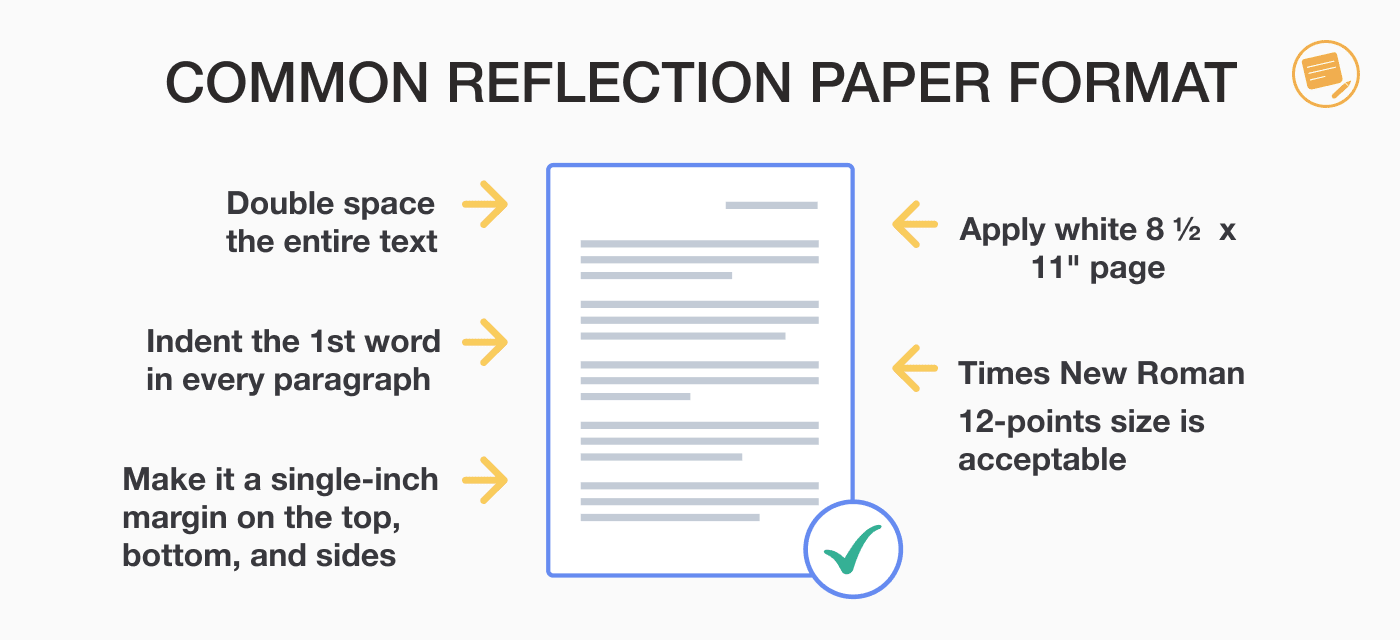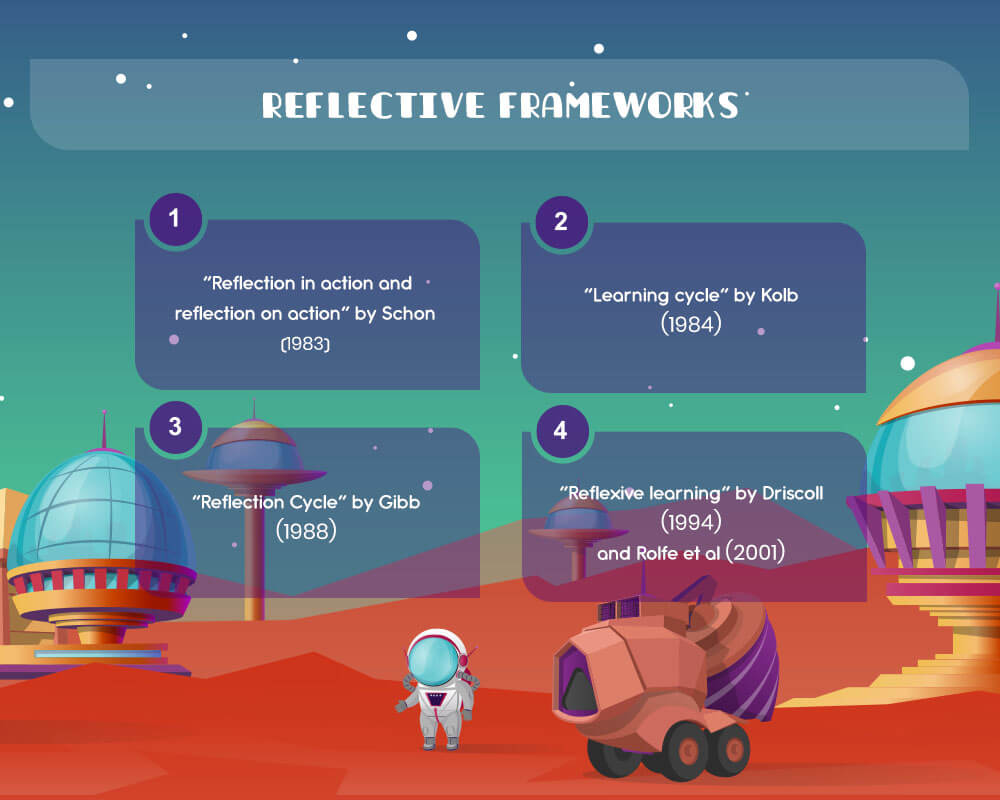
Even though a reflection paper is personal, you should keep it professional. Avoid slang and use only correct spelling and grammar. Don’t use abbreviations.
A reflective essay is a type of writing in which you describe some moment or experience from your life or share your thoughts on some text. The experience should explore your personal ideas, feelings, and opinions about the event and how it affected you. In order to write a strong reflective essay, you should not only explain the change you underwent but also support it with details and examples. For example, if you discuss becoming more optimistic in life, you would discuss how you took a positive approach and how it resulted in a good outcome.
Referring to reflective essay examples can help you a lot. A sample paper can provide you with a useful insight into how a reflection essay should look like.
A reflective paper is a very personal type of writing because it includes your feelings and opinions about something. Before adding something into your paper, ask yourself whether or not this information is appropriate to include.
Check Twice
To start organizing your reflective essay, take a look at your brainstorming table. The вЂ˜past experience’ and вЂ˜description’ should constitute less than 10% of your essay.
- The hook: grab the reader's attention in a short preview of what you’ll be writing about.
A reflective paper is the type of academic writing assignment with the aim of revealing more details about your identity.
If your instructor asks you to format your paper in APA or MLA style, here are a few shortcuts:

2. Note down any ideas that are related to the topic and if you want to, try drawing a diagram to link together any topics, theories, and ideas.
As with all written assignments, sitting down to put pen to paper (or more likely fingers to keyboard) can be daunting. But if you have put in the time and effort fleshing out a thorough plan, you should be well prepared, which will make the writing process as smooth as possible. The following points should also help ease the writing process:
Body
Next up is planning the body of your essay. This can be the hardest part of the entire paper
– Don’t think too much about how to start your first sentence or paragraph
Example reflective essay

– Don’t shy away from using a variety of punctuation. It helps keeps your writing dynamic! Doesn’t it?
Think of the outline as a map – you plan in advance the points you wish to navigate through and discuss in your writing. Your work will more likely have a clear through line of thought, making it easier for the reader to understand. It’ll also help you avoid missing out any key information, and having to go back at the end and try to fit it in.
It’s a real time-saver! Because the outline essentially serves as the essay’s ‘skeleton’, you’ll save a tremendous amount of time when writing as you’ll be really familiar with what you want to say. As such, you’ll be able to allocate more time to editing the paper and ensuring it’s of a high standard.
4. Consider how your ideas are connected to each other, then begin the writing process.

As with any conclusion, you should summarize what you’ve learned from the experience. Tell the reader how your newfound knowledge has affected your understanding of the subject in general. Describe the feeling and overall lesson you had as a result of the reading or experience.
Everyone has their own style of writing a reflective essay – and that’s the beauty of it, you have plenty of leeway with this type of paper – but, there are still a few tips everyone should incorporate.
- How did the article affect you?
- How does this article catch the reader’s attention (or does it all)?
- Has the article changed your mind about something? If so, explain how.
- Has the article left you with any questions?
- Were there any unaddressed critical issues that didn’t appear in the article?
- Does the article relate to anything from your past reading experiences?
- Does the article agree with any of your past reading experiences?
Reflection papers typically do not follow any specific format. Since it is your opinion, professors usually let you handle them any way you are comfortable with. It is best to write your thoughts freely, without guideline constraints. If your reflection paper was assigned to you, the format of your paper might depend on the criteria set by your professor. College reflection papers (also known as reflection essays) can typically range between about 400-800 words in length.
Step 1: Create a Main Theme
![]()
The body paragraphs should examine the ideas and experiences you’ve had in context to your topic. Make sure each new body paragraph starts with a topic sentence.
Another good way to organize your ideas is to write them down in a 3-column chart or table.
After you have finished reading your article, it’s time to brainstorm. We’ve got a simple brainstorming technique for writing reflection papers. Just answer some of the basic questions below:
- Short and Sweet – Most reflection papers are between 250 and 750 words. Don’t go off on tangents. Only include relevant information.
- Clear and Concise – Make your paper as clear and concise as possible. Use a strong thesis so that your essay can follow it with the same strength.
- Maintain the Right Tone – Use a professional and academic tone—even though the writing is personal.
- Cite Your Sources – Try to cite authoritative sources and experts to back up your personal opinions.
- Proofreading – Not only should you proofread for spelling and grammatical errors, but you should proofread to focus on your organization as well. Answer the question presented in the introduction.
![]()
A reflection statement is a kind of reflective writing. Usually reflective statements are assigned after interactive orals, lectures, or presentations, and are aimed to describe what was learned. This type of writing is intended to ensure that students can construct their own analysis of received information and are able to clarify confusions that they may encounter at the workplace. Students are expected to be able to determine the usefulness of information and how it will improve their practical skills.
Note: The final sentence of each paragraph summarizes and restates the idea introduced at the start of the paragraph.
The length of a reflective statement is usually dependent on the tutor’s requirements and the type of learning activity that took place. Start with describing what you expected to learn, what you have learned, and your next steps and conclusions. If you have already applied some new skills in practice, it is advisable to cover them in the reflective statement too. Check one of the examples:
The desire to learn is formed in the process of successful work on the material, therefore it is important to organize individual assistance in such a way that the student constantly feels progress is moving ahead. Experience has shown that often even a slight advancement inspires students, stimulates them to work more intensively, and increases interest in studies, and this ensures their successful mastering of the material. Individual work with students is first of all constant attention to each of them in the course of the lesson: during the interview of students, in the process of exposition and fixing of the material, as well as in explaining the homework.
Reflective Essay Writing Tips
![]()
You should be highly attentive during your classes and avoid skipping a day of writing. Consider these stages which may take more time than you think:
The structure of a reflective essay will depend on the topic, the purpose of the essay, and the model you choose to use. A properly structured essay will help you clearly present the necessary moments and address certain points.
The third part will be about your personal reflections about the event. This is the aim of your essay – to show the lessons that you have learned, as well as insights and ideas that have evolved after experiencing the event. Here you need to answer what this event means to you. For example, if you need to reflect on a certain project or class, answer these questions to ease the process of writing:
Step 1. Introduction. Every introduction to reflective essay writing should start with an attention grabber that will boost interest in your topic. The introduction is a small overview to the topic. It can be formulated as a question or contain a quote. The proposed thesis statement will be the starting point for subsequent reasoning. The reflective essay thesis statement will be about places, events, thoughts, experiences, or people that will be described further in the body paragraph. Check these examples of reflective essays or environmental design examples to get inspired and generate more ideas to start your essay.

This will give you a good frame for your paper and help you analyze your experience.
This is mostly an action plan for the future. However, if appropriate a writer can call readers to action or ask questions. Make sure that the conclusion is powerful enough for readers to remember it. In most cases, an introduction and a conclusion is the only thing your audience will remember.
There are several good ways to start a reflective essay. Remember that an introduction to a reflective essay differs depending on upon what kind of reflection is involved. A science-based introduction should be brief and direct introducing the issue you plan on discussing and its context.
This is just a selection of basic models of this type of writing. And there are more in-depth models out there if you’re writing a very advanced reflective essay. These models are good for beginner level essays. Each model has its strengths and weaknesses. So, it is best to use one that allows you to answer the set question fully.
Gibb’s (1988) Reflection Cycle

- What is the problem/ difficulty/reason for being stuck/reason for feeling bad?
- What was my role in the situation?
- What was I trying to achieve?
- What actions did I take?
- What was the response of others?
- What were the consequences for the patient / for myself / for others?
- What feeling did it evoke in the patient / in myself / in others?
- What was good and bad about the experience?
- So, what were your feelings at the time?
- So, what are your feelings now? Are there any differences? Why?
- So, what were the effects of what you did or did not do?
- So, what good emerged from the situation for yourself and others? Does anything trouble you about the experience or event?
- So, what were your experiences like in comparison to colleagues, patients, visitors, and others?
- So, what are the main reasons for feeling differently from your colleagues?
- Now, what are the implications for you, your colleagues and the patients?
- Now, what needs to happen to alter the situation?
- Now, what are you going to do about the situation?
- Now, what happens if you decide not to alter anything?
- Now, what will you do differently if faced with a similar situation?
- Now, what information would you need to deal with the situation again?
- Now, what methods would you use to go about getting that information?
Another purpose is to analyze the event or topic you are describing and emphasize how you’ll apply what you’ve learned.
Don’t forget to adjust the formatting of your essay. There are four main format styles of any academic piece. Discover all of them from our essay format guide!

